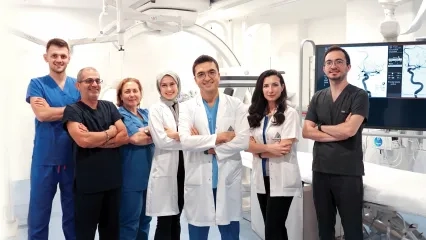Alo Yeditepe
Alo Yeditepe
Interventional Radiology
What is Interventional Radiology?
Interventional radiology is a sub-branch or upper specialty of radiology, which is the science of medical imaging, which is mostly directed to the treatment of diseases by using imaging methods. The interventional radiologist not only makes a diagnosis but also plays a role in the treatment of diseases.
Interventional Radiology Applications
Diagnostic Applications
Biopsies
Fine needle aspiration biopsies or Tru-cut biopsies accompanied by various radiological imaging techniques (Ultrasonography and/or Computed Tomography),
- Neck masses and thyroid nodules
- Thoraxial masses
- Intra-abdominal organ biopsies (Liver, pancreas, kidney)
- Bone biopsies are performed.
Arteriography Applications
It is a method of X-ray imaging of body vessels (arteries =arteries and veins=veins) using drugs. Generally, the femoral artery and rarely the axillary are entered, and the desired area is visualized by giving contrast material with the help of needles and catheters.
Angiographic Applications
- Carotid - Cerebral (neck/brain) angiography
- Arcus aortography, Thoracic (chest) angiography
- Abdominal aortography
- Renal (kidney) angiography
- Celiac/SMA (abdominal organs) angiography
- Upper/lower extremity arteriography
Angiography (Arteriography) Applications
Thanks to high-tech angiography devices, the most distal branches can be shown with high clarity with high-resolution image quality, and a 3D image can also be obtained.
Abdominal Aorta, Extremity Angiography
Arterial circulation of the distal abdominal aorta, leg, and foot is visualized.
Renal Angiography
Renal artery narrowing (renal artery stenosis), which may be a cause of hypertension, is investigated in this method. It is also applied to examine the vascular structures before and after renal transplantation in patients with suspected tumors in the kidney.
Celiac/SMA (Superior Mesenteric Artery) Angiography
Vascular pathologies of the stomach, duodenum, liver, spleen, and pancreas can be diagnosed. If the source of gastrointestinal bleeding is being investigated, treatment is usually performed along with angiography.
Thoracic Angiography
The thoracic aorta is examined in terms of dissection and aneurysm.
Arcus Aortography
Stenosis, dilation, and occlusion of the arcus aorta and brachiocephalic vessels are diagnosed.
Upper Limb Angiography
Vascular structures of the arms are evaluated. If obstruction and stenosis are detected, interventional radiological methods are applied for treatment.
Carotid/Cerebral Angiography
In these examinations, stenosis, occlusion and aneurysms, and tumors of the vascular structures of the head and neck region are diagnosed. 3D views of aneurysms can also be created, and the relationship between aneurysm-parent artery and neck before surgery and embolization can be revealed with high accuracy.
- Cerebral Angiography.
- 3-Dimensional Cerebral Angiography.
- Pulmonary Angiography: It is done to investigate pulmonary hypertension and embolism. In this method, the entry region is the femoral vein.
Venography Applications
- Superior and inferior venacavagery
- Pulmonary angiography
- Kidney venogram, Adrenal glands venography
- Upper/lower extremity venography
Inferior Venacavogram: Inferior vena cava structures, tumor blockages, and thrombus causes are revealed.
Renal Venogram: Thrombosis is investigated in the renal veins.
Adrenel Venografi: It is performed to visualize adrenal gland tumors.
Bacak Venografisi: The deep veins of the leg and abdomen are investigated for thrombosis.
Safen Ven Venografisi: Before bypass, it is conducted to evaluate the saphenous vein used as a graft.
II. Treating Applications
Thoracic Interventions: Nonvascular Applications
- Thoracentesis
- Abscess drains
- Stent applications in tracheobronchial strictures
Abdominal Interventions
Bile ducts interventions (biliary PTK, biliary drainage, biliary stenting)
Stent placement in the bile ducts,
Drainage of renal cysts and abscess collections,
RF Ablation,
Percutaneous nephrostomy,
Abscess and collection drains,
Antegrade ureteral stent,
- Biliary Stenting
- Renal Interventions
Vascular Applications
Arterial Applications
Treatment of all body vascular stenoses with balloons and stents,
- Carotid Angioplasty and Stenting
- Intracranial stent application
- Subclavian and vertebral artery stenting
- Renal Artery Angioplasty and Stenting
- Mesenteric Artery Angioplasty
- Iliac, femoral artery, and popliteal artery angioplasty
Intracranial aneurysm and embolization of arteriovenous malformations (AVM),
Intra-arterial thrombolysis in stroke cases
Caroticocavernous fistula embolization
Epistaxis, hemoptysis, and embolization in acute gastrointestinal hemorrhages
Aortic aneurysm endograft applications
Cranial and Neck Tumor Embolization
Treatment of carotid and intracranial stenoses with balloon angioplasty and stenting
Intra-arterial thrombolysis in acute stroke
In acute stroke cases, the cause may be thrombotic occlusions of the main cerebral arteries. Such pathologies can be treated within a certain time limit.
Embolization of Cerebral Aneurysms
Anterior and posterior circulation aneurysms can be embolized by direct coil or balloon modeling.
Cranial and Extracranial Arteriovenous Malformation and Embolization of Fistulas
AVM and AVF pathologies can be embolized using various embolizing agents
Balloon angioplasty and stenting of brachiocephalic, subclavian, aortoiliac, femoral, and popliteal stenoses and occlusions
Peripheral artery stenosis and occlusions can be eliminated by ensuring the patency of the arteries with balloon and stent applications.
Endograft treatment of aneurysms and pseudoaneurysms in peripheral vascular structures
With the application of covered stents, aneurysms in the thoracic and abdominal aorta, and pseudo-aneurysms in the femoral and other arteries can also be treated.
Balloon and stenting in the treatment of renal stenosis
In the treatment of hypertension, renal artery stenosis can be treated with a stent and balloon, which can be cleared.
Liver, kidney, chemoembolization, and uterine myoma embolization
In the treatment of hepatocellular carcinomas, the survival of the patient can be prolonged with intra-arterial chemoembolization. Embolization is an important alternative to surgery in the treatment of uterine myomas.
Venous applications:
- Angioplasty and stenting of venous stenosis
- Hemodialysis catheter placement
- Treatment of hemodialysis fistula stenosis with angioplasty
- Placing a filter in the Vena Cava Inferior
- TIPS
- Uterine fibroid embolization
- Venous catheter placement
Other Interventional Radiological Treatments
Diabetic Foot Treatment
Stenosis in the foot veins of diabetic patients can be treated with balloon and laser angioplasty and good results are obtained.
Oncological Applications and Treatments
Venous Port Placement
Permanent tunneled and transient venous catheter placement
In liver tumors
- RF ablation
- Transarterial chemoembolization
- Portal vein interventions
Treatment of Carotid and Intracranial Stenoses with Balloon Angioplasty and Stenting
Intraarterial Thrombolysis in Acute Stroke
In acute stroke cases, the cause may be thrombotic occlusions of the main cerebral arteries. Such pathologies can be treated within a certain time limit.
Cerebral Aneurysm Embolization
Anterior and posterior circulation aneurysms can be embolized by direct coil or balloon modeling.
Cranial and Extracranial Arteriovenous Malformation and Embolization of Fistulas
AVM and AVF pathologies can be embolized using various embolizing agents.
Balloon Angioplasty and Stenting of Brachiocephalic, Subclavian, Aortoiliac, Femoral and Popliteal Stenoses and Occlusions
Peripheral artery stenosis and occlusions can be eliminated by ensuring the patency of the arteries with balloon and stent applications.
Endograft Treatment of Aneurysms and Pseudoaneurysms in Peripheral Vascular Structures
With the application of covered stents, aneurysms in the thoracic and abdominal aorta, and pseudo-aneurysms in the femoral and other arteries can also be treated.
Balloon and Stenting in the Treatment of Renal Stenosis
In the treatment of hypertension, renal artery stenosis can be treated with a stent and balloon, which can be cleared.
Liver, Kidney, Chemoembolization, and Uterine Myoma Embolization
In the treatment of hepatocellular carcinomas, the survival of the patient can be prolonged with intraarterial chemoembolization. Embolization is an important alternative to surgery in the treatment of uterine myomas.
Venous applications:
- Angioplasty and stenting of venous stenosis
- Hemodialysis catheter placement
- Treatment of hemodialysis fistula stenosis with angioplasty
- Placing a filter in the Vena Cava Inferior
- TIPS
- Uterine fibroid embolization
- Venous catheter placement
Other Interventional Radiological Therapies
Diabetic Foot Treatment
Stenosis in the foot veins of diabetic patients can be treated with balloon and laser angioplasty and good results are obtained.
Oncological Applications and Treatments
Venous Port Placement
Permanent tunneled and transient venous catheter placement
In liver tumors;
- RF ablation
- Trans arterial chemoembolization
- Portal vein interventions
”
See Also
- Radioembolization in Liver Tumor Treatment
- Diagnosis and Treatment of Acute Stroke
- The Cause of Abdominal Pain Has Not Been Found for Years... Varicose Veins Appeared in Her Ovary
- Interventional Methods in the Treatment of Acute Stroke
- Breast MRI
- Interventional Radiology is Used in Many Fields
- What Diseases Is Interventional Radiology Used For?
- What is a Brain Aneurysm?
- Interventional Oncology
Alo Yeditepe









